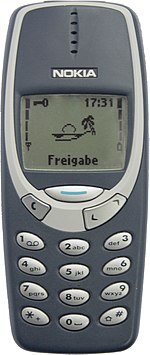 |
| http://i01.i.aliimg.com/photo/v0/106222079/FIRE_EXIT_DOOR.jpg |
 |
| Nokia 3310 - http://upload.wikimedia.org/wikipedia/commons/thumb/3/31/Nokia_3310_blue.jpg/150px-Nokia_3310_blue.jpg |
1) You go to Messages - as a response to seeing the Messages icon on the screen.
2) You write the message - as a response to seeing the large text box and a blinking cursor.
3) Once you're done, you go to 'Options' - as a response to seeing the 'Options' button.
4) Then you hit Send - as a response to seeing the send option.
5) Finally, you key in the number of the intended recipient for the message - as a response to seeing the small rectangular box that says 'number'. (or you choose a recipient from your phone book).
You can see that every step in the process is based on the assumption that if a stimulus is strong enough to trigger some behavior, then the user will respond in the correct way.
For certain things, the stimulus-response mechanism has been employed very effectively - until today. For instance, red and green colors have been consistently used to signal unsafe and safe operations respectively. Almost every new phone uses the green color to 'Answer' a call and the red to 'Reject/Decline' a call.
 |
| HTC - http://htcevo3dtips.com/wp-content/uploads/2011/09/HTC-EVO-3D-answer-call.jpg |
 |
| iPhone - http://www.filecluster.com/reviews/wp-content/uploads/2008/11/iphone_fake_calls.jpg |
 |
| Nokia - http://dailymobile.se/wp-content/uploads/2011/06/incoming_call21.jpg |
Well.. It turns out that humans are not only reactive after all. They are also intelligent proactive beings. Cognitive psychology turned upside down when we came to the realization that humans do not simply react to stimuli, but rather build expectations, anticipate events, and most importantly create mental models. And that is precisely why humans complain about things when they do not align well with their mental models. For example, before you open a water tap, you build a mental model of the path of the water. Once the water starts running, it should pour right into the sink. When it doesn't, you realize that something is off.
 |
| http://pic.epicfail.com/wp-content/uploads/2009/07/sink-fail.jpg |
 |
| Don Norman & The Design of Everyday Things |
At this point, you should also be able to explain why new phones handle sending messages the way they do. Using an iPhone or virtually any new mobile device (including Nokia devices), you will notice that the process of sending a message is pretty much the same except for one major thing. Can you guess what has changed?
The key difference is that with newer models steps 2 and 5 are swapped. You no longer type the message and then choose the recipient. You do it the other way around. Because, according to our mental model of communication, we almost always think about the recipient before we think about the exact content of the message. "I want to text Sam to see how he is doing," "I want to tell Sara that the meeting is cancelled," "I will tell everyone about the party"...etc.
In the next post of the usability series, we will expand on this concept a little bit more and look at its practical applications in building user interfaces.
No comments:
Post a Comment